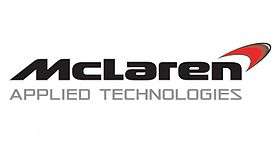McLaren Applied Technologies
 | |
| Subsidiary | |
| Founded | 1991 (as McLaren Composites) |
| Founder | Ron Dennis & Martin O'Connor) |
| Headquarters |
McLaren Technology Centre Woking, Surrey, United Kingdom |
Key people | Ian Rhodes (CEO) |
| Revenue | £37 million (2014) |
| Owner | McLaren Technology Group |
Number of employees | 500 |
| Website | http://www.mclaren.com/appliedtechnologies/ |
McLaren Applied Technologies is a British technology company that works in conjunction with companies such as GSK, NHS and more. Also its electronic division, McLaren Electronics manufactures parts for every F1 team and other sports. In September 2014, Ian Rhodes replaced the founder, Ron Dennis, as CEO of the growing technology company. McLaren Applied Technologies began as "McLaren Composites", mainly for the manufacture for parts for the McLaren F1 and Mercedes SLR. However, it began to grow and won contracts to manufacture parts for other companies and even grew into the energy industry, mainly solar panels. It was dissolved in 2003 and replaced with "McLaren Applied Technologies" a short while after in 2004. Under its old name as McLaren Composites, the company also produced landing equipment and solar panels for Beagle 2.
History
The company was formed when two McLaren Technology Group companies merged - McLaren Composites and TAG Electronics. The companies merged due to the sale of Audiolab to International Audio Group. TAG Electronics Holdings was the parent company of TAGMcLaren Audio (Now Audiolab) and also TAG Electronics Systems. When Audiolab was sold, the holding company TAG Electronics Holdings was scrapped and the remaining technology company merged with McLaren Composites, which both together now form McLaren Applied Technologies.
Business model
MAT works in three performance areas: systems, equipment, and modelling and simulation.
Clients include teams and companies in sports, health and wellness, defence, motorsports and automotive sectors.
In 2010, McLaren Applied Technologies developed systems that supported Team GB's 2012 London Olympics medal bids in rowing, sailing and cycling.[1]
MAT worked with Specialized Bicycle Components to produce the Specialized S-Works+McLaren Venge racing bike, as ridden by Mark Cavendish.[2]
McLaren Applied Technologies enabled GlaxoSmithKline's toothpaste production line at Maidenhead to cut the time it takes to change over one toothpaste brand or flavour to another from 39 minutes to 15 minutes, resulting in the factory becoming more productive to the tune of 6.7m tubes of toothpaste a year.[3]
McLaren Applied Technology Centre
On 16 September 2011, McLaren Group unveiled plans to build a McLaren Applied Technology Centre adjacent to its existing headquarters. The new building will consist of 60,000 square metres (650,000 sq ft) of workshops, prototype manufacturing and testing space, research and development equipment, offices, meeting spaces, innovation hubs and informal break-out spaces. Plans include 300 jobs during construction and 400 permanent jobs once the site has been built. McLaren also claims that an additional 200 jobs will be created indirectly through manufacturing, suppliers and clients, and increased retail spending in the area.[4] These jobs were created and the money was spent, but on a production centre for McLaren's 82% owned, McLaren Automotive. The money for the technology centre was spent on this new large production centre to produce sports cars such as the McLaren 12C, McLaren P1, McLaren 650S and more.
Energy
McLaren Applied Technologies handles electronics and data for the Ekofisk drilling plant in the North Sea. The MAT ENERGY website states: "MAT has taken its knowledge of analysing large data sets and applied it to drilling. Using real time data direct from the drilling head, the computer models developed by MAT constantly updates and provides insight that helps guide operational decision making on a day-to-day basis." MAT also work with Wind Turbines companies and data centre companies. More well known, McLaren Applied Technologies works with IO on the design of their data centres and cooling systems for IO.
Electronics
McLaren Electronic Systems is a brand of electronic systems for racing cars created and manufactured by McLaren Applied Technologies. The company has won multiple Queen's Awards for Enterprise for innovation and international trade.[5] McLaren have supplied the single electronic control unit used in all Formula One cars since 2008,[6] and also supply software, sensors and other components to Formula One teams. MES also supply the powertrain control system used in McLaren's Formula One race cars.
In addition to Formula One, McLaren also provide the engine control units used in the NASCAR Sprint Cup and IndyCar Series. The two ECU's share a common base,[7] and McLaren have held the contract for both series since 2012 (previously Sprint Cup Series's ECU supplier was a free choice and IndyCar Series's ECU supplier was Motorola). McLaren Electronic Systems produces the electric motor, transmission and electronics used in the Spark-Renault SRT 01E, the car used in the inaugural Formula E season.[8]
GlaxoSmithKline plc
GlaxoSmithKline work with MAT on developing drugs, vaccines and medication and also plan to open a third building at the McLaren Technology Centre together named the McLaren-GSK Centre for Applied Technologies. MAT also helps develop some household brands of GlaxoSmithKline including Aquafresh, Horlicks, Sensodyne, NiQuittin and more.
References
- ↑ Owen Gibson (18 January 2010). "2012 Olympic team borrows F1 technology". The Guardian.
- ↑ "Innovation / Consumer Brands: Specialized". McLaren Group. Retrieved 26 July 2014.
- ↑ Angela Monaghan (9 March 2014). "UK in pole position to benefit from F1 engineering skills". The Guardian.
- ↑ Hats off to Ron Dennis. Tom Cary. Formula One Daily Telegraph. 16 September 2011.
- ↑ Allen, James (22 April 2013). "McLaren Electronic Systems wins Queen's Award for International Trade". Jamesallenonf1.com. Retrieved 29 January 2015.
- ↑ "FIA World Motorsport council awards Single ECU Contract". FIA.com. Fed. 5 June 2007. Archived from the original on 13 July 2010. Retrieved 29 January 2015.
- ↑ "The Power Inside NASCAR Fuel Injection" (PDF). Freescale Semiconductors. Retrieved 2 June 2013.
- ↑ Corrêa, João (10 September 2013). "McLaren the power behind Formula E". Motorsport.com. Archived from the original on 6 October 2013. Retrieved 29 January 2015.